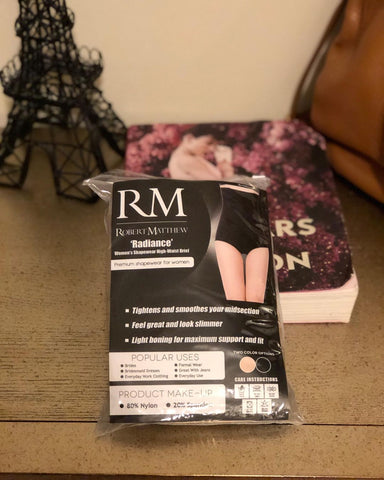Shapewear and Clothing Fabrics: A Guide to Finding the Perfect Fit

Shapewear has become a popular choice for individuals seeking a little extra support and confidence in their outfits. However, one common concern is how shapewear interacts with different types of clothing fabrics, particularly lightweight or sheer materials. In this blog, we will explore the relationship between shapewear and various fabric types, providing insights and tips to ensure a seamless and comfortable fit.
Understanding Shapewear Fabrics:
To understand how shapewear interacts with different clothing fabrics, it's important to first understand the fabrics used in shapewear itself. Shapewear typically utilizes a combination of synthetic materials such as nylon, spandex, and polyester. These fabrics are chosen for their stretchability, durability, and ability to provide the desired compression and shaping effect.
When selecting shapewear, it's essential to consider the fabric composition and construction. Look for shapewear that is breathable, moisture-wicking, and hypoallergenic to ensure comfort and skin health.

Lightweight Fabrics and Shapewear:
Lightweight fabrics, such as silk, chiffon, or fine cotton, can pose a challenge when paired with shapewear. The goal is to create a smooth and seamless silhouette without visible lines or bunching. When choosing shapewear for lightweight fabrics, opt for seamless options that have minimal stitching and construction details.
Seamless shapewear is designed to provide a discreet fit under lightweight fabrics, as it has no visible seams or edges that could create unwanted lines or texture. Look for shapewear with laser-cut edges or bonded seams to ensure a seamless appearance and a comfortable fit.

Sheer Fabrics and Shapewear:
Sheer fabrics like lace, mesh, or organza require careful consideration when selecting shapewear. The transparency of these fabrics means that visible seams or texture from the shapewear can be more apparent. To achieve a smooth and flawless look, choose shapewear that has a smooth and sleek surface, free of any embellishments or textures that could show through sheer fabrics.
Opt for shapewear in nude or skin-tone shades that closely match your natural skin tone. This minimizes visibility and creates a seamless blend between the shapewear and the sheer fabric, ensuring a discreet and flattering appearance.

Consider Compression Levels:
The compression level of shapewear plays a significant role in how it interacts with different fabrics. Higher compression garments tend to have more structure and may be better suited for thicker or sturdier fabrics. However, when dealing with lightweight or sheer fabrics, opting for light to medium compression shapewear is recommended.
Light to medium compression shapewear provides a subtle smoothing effect without adding bulk or unnecessary rigidity. This allows the fabric of your clothing to drape naturally while still providing the desired shaping and support.

Sizing and Fit:
Proper sizing and fit are crucial when it comes to shapewear and fabric interactions. Ill-fitting shapewear can lead to discomfort, visible lines, or even fabric distortion. When selecting shapewear, follow the sizing guidelines provided by the manufacturer and take accurate measurements to ensure the right fit.
Avoid sizing down in an attempt to achieve more compression, as this can lead to the shapewear digging into the skin or creating unsightly bulges. Choosing the correct size will ensure that the shapewear provides the intended support while remaining comfortable and seamless under different fabric types.

Layering and Additional Clothing:
Layering is often a helpful technique when wearing shapewear with lightweight or sheer fabrics. By adding an extra layer between the shapewear and the delicate fabric, you provide additional coverage and minimize the risk of any texture or seam lines showing through.
Consider wearing a slip, camisole, or lightweight undershirt over the shapewear to create a barrier and ensure a smooth appearance. This extra layer not only adds a level of protection to the fabric but also helps in creating a more polished and refined look.

Test and Experiment:
It's essential to try on different combinations of shapewear and clothing fabrics before making a final decision. Testing how the shapewear interacts with your specific garments will allow you to assess the overall appearance and comfort.
Walk, sit, and move around to ensure that the shapewear remains discreet and comfortable in various positions and movements. By testing different combinations, you can determine which shapewear pieces work best with your preferred clothing fabrics, guaranteeing a seamless and flattering look.

Personal Comfort and Preference:
While it's crucial to consider fabric interactions and recommendations, personal comfort and preference should guide your choice of shapewear and fabric combinations. Every individual's body shape, fabric choice, and desired level of shaping are unique, so trust your own judgment and prioritize your comfort and confidence.
Experiment with different brands, styles, and fabrics to find the combination that works best for you. It may take some trial and error to discover the perfect balance between shapewear and clothing fabrics, but embracing the versatility of shapewear will allow you to confidently wear your favorite outfits.

Shapewear can be a valuable tool for achieving a sleek and confident look, even when wearing lightweight or sheer fabrics. By understanding the fabrics used in shapewear, considering compression levels, focusing on sizing and fit, exploring layering options, and testing different combinations, you can find the perfect balance between shapewear and clothing fabrics.
Embrace the versatility of shapewear and feel empowered to confidently wear your favorite outfits, knowing that your shapewear will enhance your natural curves while remaining discreet and comfortable. With the right knowledge and a little experimentation, you can achieve a seamless and flattering look regardless of the fabric you choose to wear.


Leave a comment